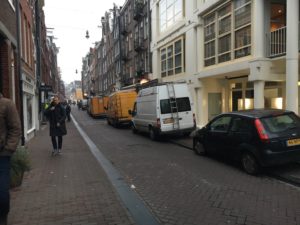Delivery vans circling the streets, trying to find a parking spot, or in the lack thereof, decide to double park; it happens in every city. It is inefficient and a hassle for both the driver as well as the city’s occupants. In order to fight this problem, Amsterdam has started a trial with reserved parking spots for delivery vans. They will directly travel to this spot and no longer need to load and/or unload on the street. The logistic sector can therefore work more efficiently and budget-friendly. And the pressure to find parking and traffic congestion will decrease.
Purposefully to the right parking spot
PostNL has kindly offered her delivery vans for this trial. These vans are connected to the central system that will schedule an efficient route in order to deliver the packages. The system reserves also the required smart parking spots along this route. The parking spot will register whether it is available or not for itself. The driver will then be informed via the navigational system of the delivery van where he/she needs to go and/or whether there is a reserved loading/unloading spot available.
From research to reality
The Hogeschool van Amsterdam (Amsterdam University of Applied Sciences) is researching the results of this dynamic solution regarding logistics, but also the effect on the liveability of the city. Will this technology help create a better living environment? Is there a viable business case?
Technolution makes this innovation a reality by integrating all the technical systems. For instance, the parking sensors are connected to an open database and this database provides and receives data from the municipality and the logistic partners. As a result of this data, a recommendation of the route is made and the parking spots can then be reserved in real time.
Technolution and Glimworm are collaborating to create a dynamic sign, Sparks, which will be located at the loading/unloading spots. This sign is not only used in Amsterdam, but also in Maastricht and Rotterdam. In these cities, the sign is being used to indicate whether or not it is being used for loading/unloading or whether it is currently being used for another purpose. This function was prompted by the dynamic urban space movement. For example: in the evenings, the parking spot can be used as a terrace for the adjacent restaurant or even as a playground for children living in the city.
From regulation to solution
The municipality of Amsterdam is providing several existing loading/unloading spots for this trial. In the context of future environmental regulations this could possibly mean that a transporter can only access the city when he/she has actually booked such a parking spot. The association of undertakings EVO is looking at this solution from a wider perspective. It offers a flexible solution for moving companies and contractors that currently have to file an official application before being able to work out on the streets.
European project for the knowledge development
The parking trail is part of the European Sailor project: smart last mile commerce. In four European cities, these practical trials are established to improve the effectiveness, efficiency and sustainability of the logistics in Europe. In addition to Amsterdam there are also demonstration locations in Borlänge (Sweden), Graz (Austria) and San Sebastian (Spain). The trial started 1 July 2016 and will last for two years.
Source: Technolution

